Automate Content Marketing to Boost Results Fast
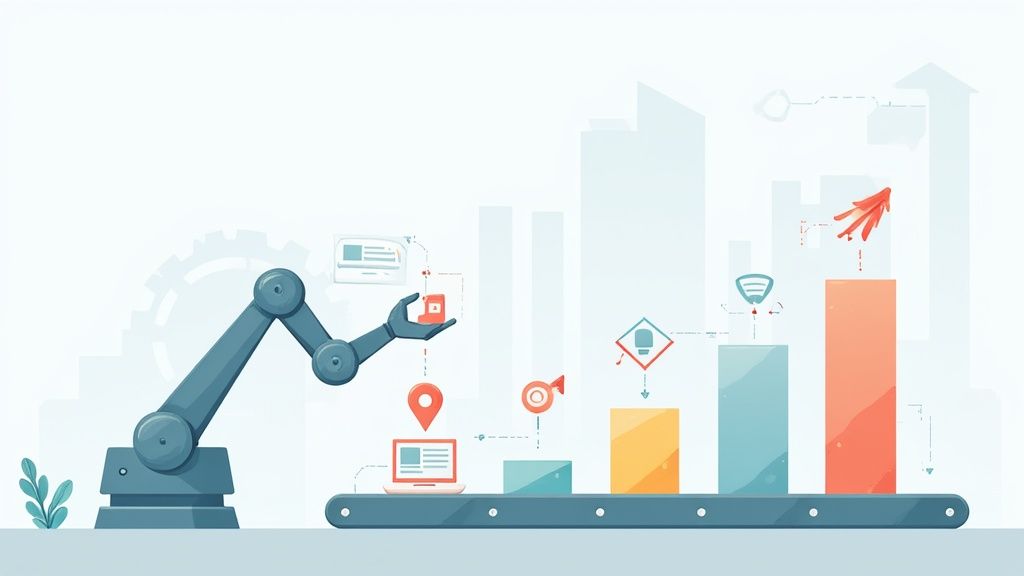
Why Manual Content Marketing No Longer Works
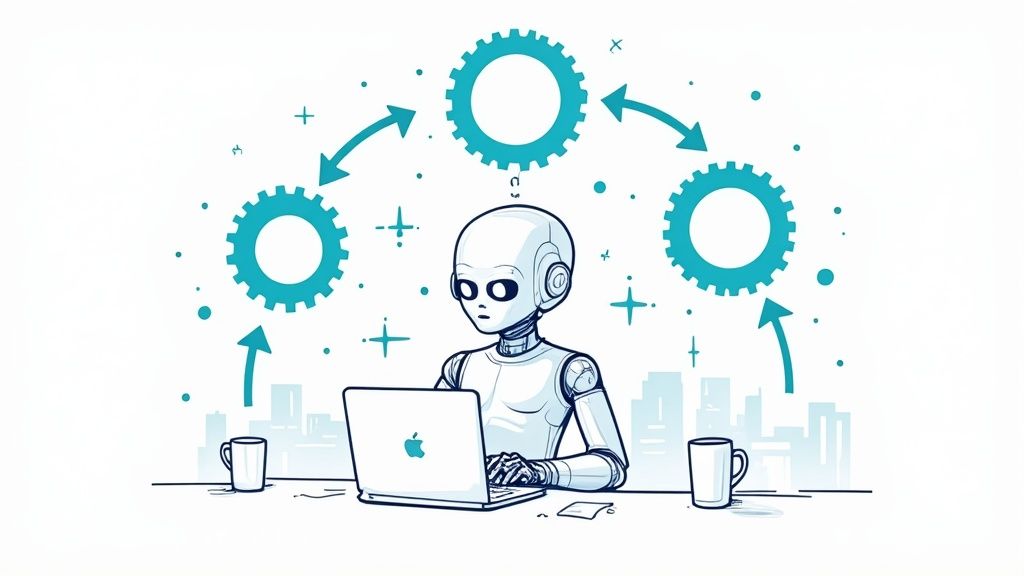
In today’s fast-moving digital world, relying solely on manual content marketing processes is inefficient. It's like trying to compete in a Formula 1 race with a bicycle. The demands of modern content creation, including volume and personalization, simply outpace the capabilities of manual methods. This leaves businesses struggling to maintain momentum and wasting precious time and resources.
The Breaking Point: Where Manual Processes Fail
Imagine your content team as a well-oiled machine. Manual processes introduce friction, slowing down operations and ultimately leading to burnout. Tasks like keyword research using tools like Semrush, content scheduling on platforms like Hootsuite, and performance analysis can take hours when done by hand. This leaves less time for the essential work: crafting engaging, high-quality content that resonates with your audience.
Inconsistency is another significant drawback. Manual processes often result in variations in messaging and branding, weakening your overall brand identity. Additionally, manual methods can make it difficult to react to trending topics and engage with your audience in real-time.
The Cost of Inaction: Falling Behind the Competition
While your team grapples with manual tasks, competitors are likely scaling their content efforts with automation tools. This allows them to connect with a broader audience through personalized content delivered across various channels. They’re also gathering valuable data and insights that inform future content strategies.
This creates a significant competitive advantage. They're building stronger brand awareness, generating more leads, and ultimately driving greater revenue growth. Staying with manual processes means risking being left behind in the digital dust.
The Rise of Automation: A Necessary Shift
The growing demand for content, combined with advancements in marketing technology, has made automation essential for success. This is evident in the projected growth of the content marketing industry. By 2026, the industry is expected to reach $107 billion in revenue, fueled partly by advancements in marketing automation technologies.
This growth underscores the importance of automation in achieving efficiency and targeted content delivery. Discover more insights about content marketing statistics. Automation frees teams from tedious, repetitive tasks, allowing them to focus on strategic initiatives and creative endeavors that drive real results. It ensures consistent brand messaging, personalized content delivery, and data-driven optimization, ultimately maximizing your return on investment.
AI's Evolving Role in Content Marketing Transformation
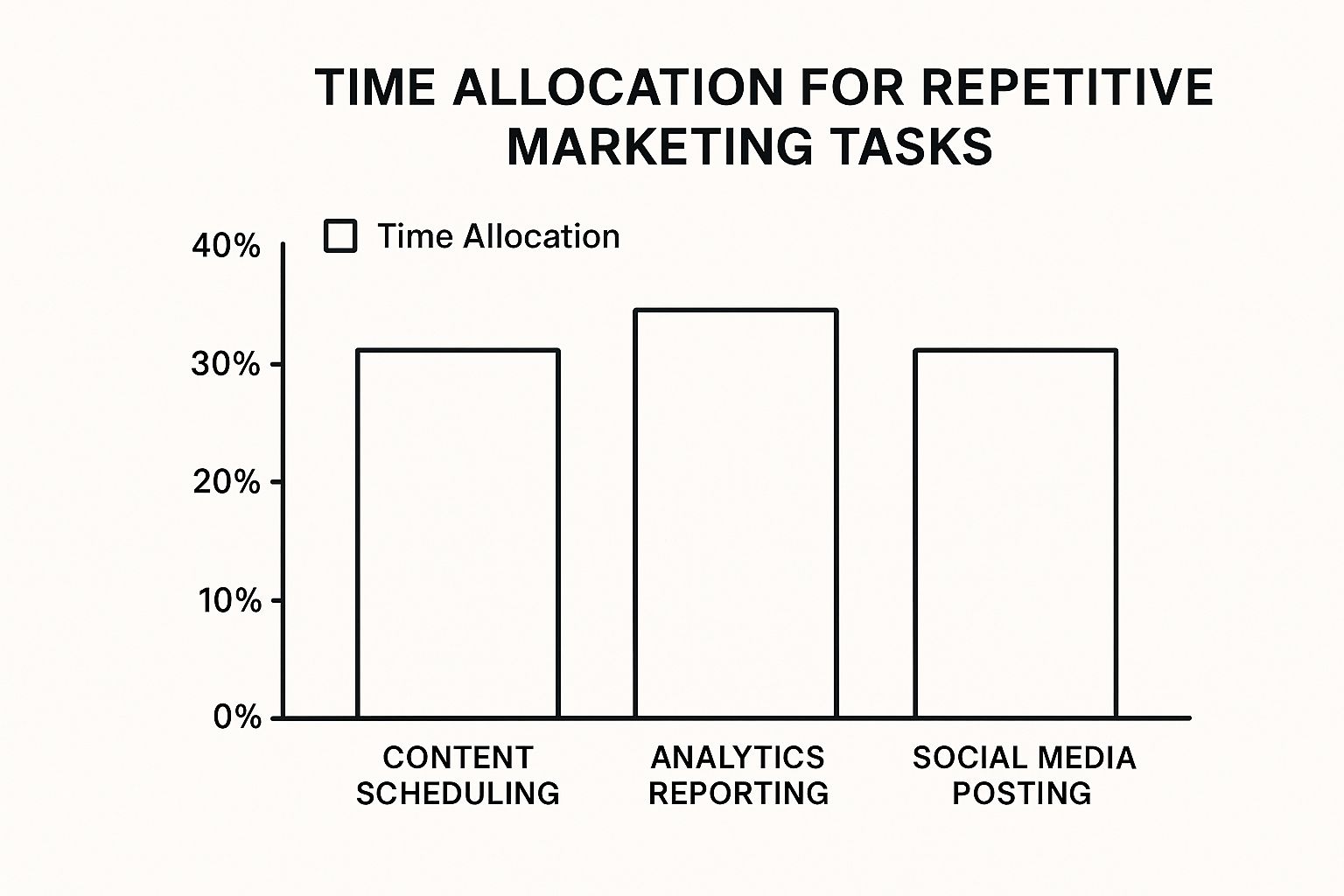
There's a lot of talk about Artificial Intelligence (AI) in content marketing. But what does it really offer? This section explores how brands are using AI effectively, balancing efficiency with a genuine brand voice.
Understanding AI's Impact on Content Creation
AI is transforming content marketing. It's used throughout the content lifecycle, from brainstorming ideas and writing copy to optimizing for search engines like Google and personalizing how content is delivered. AI-powered tools can analyze large amounts of data to find trending topics and suggest useful keywords, saving marketers time and effort. AI can also create different versions of content for specific audiences, boosting engagement and personalization.
Balancing AI Efficiency with Authentic Brand Voice
A key challenge with AI in content marketing is keeping a unique and authentic brand voice. AI can generate text quickly, but it can sometimes lack the human touch. This is where the human-AI partnership is important. Smart brands use AI for tasks like repurposing content and scheduling social media posts. This frees up human writers to focus on strategy and crafting compelling stories that connect with their audience.
This collaborative approach helps businesses automate their content marketing without losing the personal connection that builds brand loyalty. It also allows for scaling personalized content across different channels, something that's difficult to do manually.
Where Automation Thrives and Human Oversight Remains Critical
Some content types are perfect for automation. Social media updates, product descriptions, and even basic news reports can be efficiently generated and shared using AI tools. However, more complex or emotional content, like thought leadership articles or opinion pieces, still need human input.
AI can be a great assistant, helping with research, creating outlines, and even suggesting different wording. But the strategic thinking, creative storytelling, and deep understanding of the audience still rely on human writers.
The Growing Adoption of AI in Marketing
A significant trend in automating content marketing is the increased use of AI. By 2025, AI is expected to improve automation, personalization, and data analysis across the industry. Content creation is the leading AI application in marketing, making up 35% of its use. An impressive 86% of marketers say they save at least one hour on creative tasks using AI. This increased efficiency lets marketers focus on bigger strategic goals and boosts productivity. Learn more: Explore this topic further.
The following data chart visually represents the adoption rates of different AI applications in content marketing.
[Space for Infographic - Bar Chart illustrating the following data points]
- Content Creation: 35%
- SEO Optimization: 25%
- Content Distribution: 20%
- Content Analytics: 15%
- Personalization: 5%
The chart clearly shows that content creation is the most popular area for AI, followed by SEO optimization and content distribution. Lower adoption rates for content analytics and personalization suggest these areas are ripe for future growth. As AI technology continues to evolve, we can expect these numbers to change, potentially leading to even better results in content marketing. This presents opportunities for businesses to leverage AI to automate and optimize their content strategies.
Let's explore how AI is impacting specific content marketing tasks:
AI Applications in Content Marketing
This table compares different AI applications in content marketing and their impact on efficiency and effectiveness.
| AI Application | Primary Use Cases | Reported Time Savings | Quality Impact | Adoption Rate |
|---|---|---|---|---|
| Content Creation | Blog posts, social media copy, product descriptions | Average of 1-2 hours per task | Improves consistency and output; creativity still requires human input | 35% |
| SEO Optimization | Keyword research, content optimization, link building | Reduces research time by 50% or more | Improves search rankings and organic traffic | 25% |
| Content Distribution | Social media scheduling, email marketing, content promotion | Automates repetitive tasks, freeing up marketers' time | Increases reach and engagement | 20% |
| Content Analytics | Performance tracking, audience insights, content analysis | Automates data gathering and reporting | Provides data-driven insights for content strategy | 15% |
| Personalization | Targeted content recommendations, dynamic email content, personalized website experiences | Difficult to quantify, but improves relevance | Improves user experience and conversions | 5% |
Key takeaways from the table include the high adoption rate of AI for content creation and SEO optimization, along with the significant time savings reported by marketers. While AI is transforming content marketing, the quality impact varies depending on the application, with some areas still requiring substantial human input.
Building Your Automation Tech Stack That Actually Works
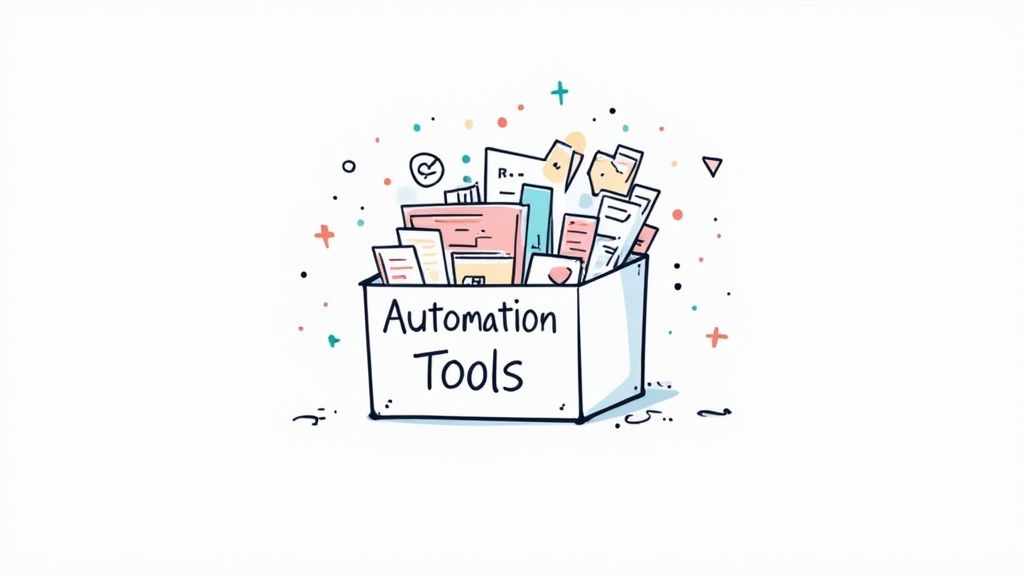
Stop wasting your budget on the newest marketing automation tools without a solid plan. Constructing a tech stack that genuinely automates your content marketing requires thoughtful planning and integration. It's about selecting the perfect tools for your particular needs and connecting them efficiently.
Key Considerations When Choosing Automation Tools
Don't get distracted by fancy bells and whistles. Instead, prioritize core functionalities. Think about how effectively a tool meshes with your current systems. A disconnected tech stack creates more headaches than solutions. Scalability is also essential. Opt for tools that can expand with your business, preventing expensive replacements later. Always seek a demonstrable return on investment (ROI). Automation should simplify your workflow and boost results, not just add unnecessary complexity.
Essential Components of an Effective Content Marketing Automation Stack
A powerful content marketing automation stack generally includes a few key components. These tools collaborate to automate different phases of the content lifecycle, from initial planning and creation to final distribution and analysis.
Content Planning and Scheduling: Tools like Trello or Asana help structure ideas, oversee editorial calendars, and delegate tasks, guaranteeing consistent content production.
Content Creation and Optimization: AI writing assistants can create initial drafts and refine existing content for SEO. Grammarly helps refine your writing, maintaining a professional standard.
Content Distribution and Promotion: Platforms like Buffer or Hootsuite automate social media posts, ensuring your content reaches the right people at the best times. Email marketing platforms automate email campaigns, cultivating leads and driving conversions.
Content Analytics and Reporting: Tools like Google Analytics offer vital data on content performance. This data helps gauge the impact of your content strategy and pinpoint areas for improvement. The move towards marketing automation tools is growing. By 2025, projections show 35% of businesses will automate content management, with an additional 29% automating landing pages. Find more detailed statistics here.
Implementing Your Automation Stack: Step-by-Step
Building your automation tech stack isn't a one-size-fits-all endeavor. The ideal strategy depends on your team’s size, budget, and specific content objectives.
Start Small: Begin by automating one or two key processes, such as social media scheduling or email marketing. As your team adapts to these tools, progressively broaden your automation efforts.
Prioritize Integration: Guarantee smooth data transfer between tools. This eliminates manual data entry and ensures accurate reporting.
Test and Refine: Regularly track the performance of your automation tools. Adapt and adjust as necessary to maximize efficiency and results.
Avoiding Common Pitfalls and Hidden Costs
While automation offers significant advantages, it's important to recognize possible drawbacks. Some tools come with steep learning curves, requiring substantial time and resources for training. Hidden costs, like integration fees or premium features, can also impact your budget. Excessive dependence on automation can also diminish the genuine, human touch in your content. Striking a balance between automation and human involvement is key. Read also: How to master the 2024 LinkedIn algorithm.
By concentrating on these elements, you can create an automation tech stack that streamlines your operations, enhances content quality, and generates a measurable ROI. This frees you to concentrate on the strategic and creative sides of content marketing, delivering meaningful results for your business.
Content Distribution Systems That Drive Engagement
Crafting top-notch content is only one piece of the puzzle. Ensuring it's seen by the right people is the other, and this is often where content marketing strategies stumble. Automating your content marketing is the key. Leading brands are now building automated distribution systems that ensure their content reaches the right audience at the most opportune moments.
Channel-Specific Distribution: Tailoring Your Approach
Creating channel-specific distribution rules is vital for maximizing engagement. Consider the different platforms you use. Each has its own unique audience and best practices. For instance, LinkedIn thrives on professional, long-form content, while TikTok favors short, engaging video clips.
Understanding these nuances allows you to automate distribution in a way that aligns with each platform's expectations. This approach respects audience preferences while maintaining a consistent brand message. For those interested in maximizing their LinkedIn presence, check out this helpful resource: 7 types of content to boost your LinkedIn presence.
Trigger-Based Systems: Responding to Audience Behavior
Going beyond static content calendars, trigger-based distribution provides a more dynamic strategy. These systems respond directly to audience behaviors, delivering content precisely when it's most relevant. Instead of scheduling a post for a specific time, you can trigger its distribution based on user actions.
Examples of triggers include downloading a resource or signing up for a newsletter. This personalized approach nurtures leads and fosters stronger relationships with your audience.
Multi-Channel Distribution: Expanding Your Reach
Automation empowers multi-channel distribution in a way that’s simply impossible to manage manually. Imagine consistently posting across five or six platforms daily. It's time-consuming and prone to errors. Automated systems streamline this process.
With automation, you can easily schedule and distribute content across numerous channels simultaneously, ensuring consistent messaging and expanding your overall reach.
Maintaining Quality and Personalization at Scale
As you expand your content distribution, quality control is essential. Automated systems should include checks and balances. These safeguards ensure content aligns with your brand guidelines and maintains a high standard. This may involve incorporating review processes or leveraging tools that automatically flag potential problems.
Personalization at scale doesn't have to be overly complex. By segmenting your audience and using dynamic content, you can automate tailored messaging efficiently. This avoids the need to create individual campaigns for every user, allowing you to scale personalized content delivery, boost engagement, and drive conversions effectively.
Measuring What Matters: The Real ROI of Automation
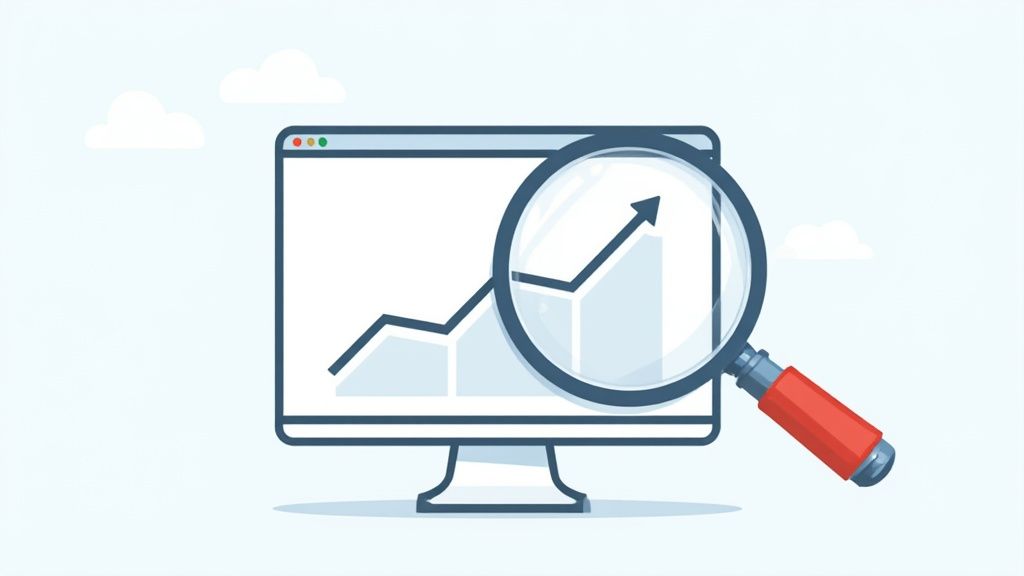
How can you prove that automating your content marketing is actually improving your bottom line? It's not about superficial metrics like likes and shares. It's about understanding the real impact of your automation investment. This means focusing on metrics that demonstrate actual business growth.
Key Performance Indicators (KPIs) for Automation Success
Choosing the right KPIs is crucial for measuring the effectiveness of your automation strategy. These KPIs should align with the main goals of your content marketing, like boosting brand awareness, generating leads, and ultimately, driving revenue growth.
For example, if your goal is lead generation, tracking the number of leads generated through automated content distribution is a key KPI. Tracking the conversion rate of those leads offers further insights into your automation efforts.
Building a Measurement System
A solid measurement system is essential for capturing both the immediate and long-term benefits of content automation. This system should track the KPIs identified above and provide regular reports to monitor progress and identify areas for improvement.
A dashboard could be created to visualize key metrics and track progress towards goals. This dashboard might include data on time saved, content performance, and financial outcomes. This provides a complete overview of automation's impact.
Consider how these improvements translate into financial gains. Are leads converting into customers at a higher rate? Is your cost per acquisition decreasing? These are the questions that will help you understand the true ROI of automation.
To help visualize the impact of automation on your content marketing ROI, let's look at some key metrics:
To help visualize the impact of automation on your content marketing ROI, let's look at some key metrics in the table below. This table illustrates how different aspects of content marketing automation can be measured and what kind of improvements you might expect.
Content Marketing Automation ROI Metrics
This table presents key metrics for measuring the return on investment from content marketing automation initiatives.
| Metric Category | Specific KPIs | Measurement Method | Typical Improvement Range | Calculation Formula |
|---|---|---|---|---|
| Efficiency Gains | Time saved on content scheduling | Compare time spent before and after automation | 10-20% | (Time before automation - Time after automation) / Time before automation |
| Content Performance | Website traffic | Google Analytics | 5-15% | (Traffic after automation - Traffic before automation) / Traffic before automation |
| Content Performance | Lead generation | CRM or Marketing Automation Platform | 15-25% | (Leads after automation - Leads before automation) / Leads before automation |
| Financial Outcomes | Cost per acquisition (CPA) | Marketing spend / Number of customers acquired | 10-20% decrease | Marketing spend / Number of customers acquired |
This table provides a framework for measuring the impact of automation on various aspects of content marketing. By tracking these metrics, you can demonstrate the real value of your automation efforts.
Communicating Automation Value
Showing the value of your automation strategy to stakeholders requires clear communication. Create dashboards that visualize key metrics and reports that showcase automation's impact on business outcomes. Connect technical improvements to business priorities, showing how automation contributes to overall growth.
Consider the narrative. Has automation enabled your team to shift from reactive to proactive content marketing? For example, a marketing team might present a case study showing how automation increased lead generation by 20% while reducing marketing costs by 10%. This data clearly illustrates automation's positive impact. You might be interested in: How to master content repurposing.
Optimizing Based on Performance Data
Finally, use performance data to identify optimization opportunities and continually refine your automation strategy. Analyze data on efficiency gains, content performance, and financial outcomes to pinpoint areas where automation can be further leveraged or adjusted. This data-driven approach ensures your automation efforts are continually optimized. This might involve testing different automation tools, adjusting content distribution strategies, or refining target audience segmentation.
Creating a Sustainable Automation Strategy That Evolves
Building a successful automated content marketing strategy isn't about throwing technology at the problem and hoping for the best. It's about creating a thoughtful, adaptable approach. Think of it like constructing a building: you wouldn't just throw up a shed and hope it stands the test of time. You'd build a solid foundation and plan for future expansion. This section explores building an automation roadmap that delivers both quick wins and long-term growth.
Assessing Your Current Content Operations
Before automating anything, understand your existing content processes. It’s like taking stock of your kitchen before a remodel. You need to know what appliances you have, what works, and what needs replacing. This assessment involves analyzing current workflows, identifying bottlenecks, and pinpointing areas where automation can have the biggest impact.
For example, if your team spends hours scheduling social media posts, that's a prime automation candidate. Repetitive tasks like formatting blog posts or generating reports can also be easily automated.
Prioritizing High-Impact Automation Opportunities
Not every automation opportunity offers the same return. Some offer significant ROI, while others provide minimal improvements. Prioritize areas where automation maximizes efficiency, content quality, and business outcomes. Focus on initial "quick wins" to demonstrate automation's value and gain momentum for larger projects.
This might involve a simple cost-benefit analysis, weighing the potential time and cost savings against the investment required for implementation.
Building a Phased Implementation Plan
Avoid trying to automate everything at once. A phased approach is more manageable and less likely to overwhelm your team. Start with one or two key areas, ensure they run smoothly, then move to the next phase. This allows your team to gradually adapt to new tools and processes, increasing the chances of success.
Like building a house, start with a solid foundation (maybe automating social media scheduling) before moving to the roof (perhaps automating content repurposing). Each phase builds on the last, creating a robust and scalable automation infrastructure.
Managing the Human Side of Automation
Automation isn't about replacing people with robots. It's about empowering people to do more meaningful work. This requires addressing the human element, including team buy-in, redefining roles, and developing new skills.
For example, writers who previously spent hours formatting can now focus on creating compelling content. This shift requires training and support so team members feel comfortable with new responsibilities.
Establishing Governance Frameworks
As you automate more content marketing, clear governance is crucial. These frameworks ensure automated content aligns with brand guidelines, maintains quality, and meets regulatory requirements. This might involve review processes or tools that flag potential compliance issues.
Think of these frameworks as the "building codes" for your automated content. They ensure consistency, prevent errors, and build audience trust.
Building Adaptable and Flexible Systems
Technology is always changing. Your automation systems need the flexibility to adapt to new tools, platforms, and market conditions without requiring significant overhauls. This might involve choosing modular tools that integrate well with other systems or building in redundancies to withstand technological shifts.
Like a building designed for earthquakes, your automation strategy needs resilience and adaptability. This ensures your content marketing efforts remain effective and efficient long-term.
Ready to transform your content marketing? Lumeo offers an innovative platform to create compelling visual content that maximizes online visibility and boosts engagement. Turn existing content into dynamic carousels optimized for LinkedIn, Instagram, and TikTok. Visit Lumeo to learn more and start building your automated content marketing strategy today.